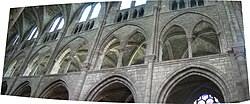Notre-Dame-en-Vaux

The Notre-Dame-en-Vaux ( "Our Lady in the Valleys" ) collegiate church is a collegiate and pilgrimage church in the French city of Châlons-en-Champagne in the Marne department .
description
There is evidence of a previous building called "Sancta Maria de Vallibus" at the site of today's church from at least 850. Since the beginning of the 12th century, in a phase of economic boom for Châlons, it had a collegiate chapter and also served as a parish church .
There is evidence that work on the new church began before 1157. Parts of the building collapsed that year. Parts of the transept and the two eastern towers that flank the choir remained standing. In the following construction phase, the lower parts of the nave, the two western towers and the portal of the southern transept were built. Up to this point, a Romanesque - Gothic mixed style was used. Only the construction phases after 1180 gave the church its Gothic face. The nave was raised and the beamed ceiling replaced with vaults , galleries were built above the side aisles , also with ribbed vaults , the transept was raised by one storey, and the choir was completely rebuilt. The master builders succeeded in creating a harmonious whole, despite the changed construction method, as well as placing the vaults firmly on pillars that were not originally intended for this. In the 13th century, all four church towers were given wooden spiers, and the Gothic south portal was completed in 1469.
The choir, like the aisles and transepts, has four floors and was built between the two older towers. It is noticeable that their position is not symmetrical. On the north side the ambulatory extends to the transept, and the tower stands outside, to the south the tower interrupts the walkway . Obviously, old foundations were reused here. Five apse chapels are attached to the walkway . The two outer ones are rectangular, the three middle ones are polygonal.
At the time of the French Revolution , three of the four wooden spiers were torn down, the southern portal was badly damaged and large parts of the figurative decorations were removed. In the middle of the 19th century, at least the second western tower got its top back. In 1864 the church also received a carillon consisting of 56 bells , one of the largest in Europe at the time.
Leaded glass window
The oldest preserved church windows in the choir date from the 12th century. Much more noteworthy, however, are some of the 16th century windows in the aisles. They were donated by wealthy parishioners between 1525 and 1530. They are attributed to the glass painter Mathieu Bléville and show the Passion of Christ, the life of Mary and the life of the Apostle James. Two other windows in Bléville were originally donated by the Brotherhood of the Pilgrims to St. James for the infirmary Saint-Jacques, which has been attested since the 13th century. They were acquired in 1678 by sextons of the Notre-Dame church and also built into side chapels. It is to this fact that the church owes its 1998 award as part of the UNESCO World Heritage “Camino de Santiago in France”.
See also the description of the following windows:
- Battle of Clavijo
- Glorification of the Virgin
- Life of the virgin
- Birth of jesus
- Descent from the Cross
Cloister
The canons built a cloister on the north side of the church in the 12th century . It was decorated with unique decorations: pillars were designed as figures of saints, the capitals show entire biblical scenes. Between 1759 and 1766 the cloister was demolished when it was considered out of date. It was not until the 1960s that parts of the sculptures were found again during an archaeological excavation. They have been exhibited in their own museum since 1978.
See also
Web links
- WHC Nomination Documentation (PDF, 88.9 MB!), Application documents for the nomination as World Heritage, here: Section "Châlons-en-Champagne, Eglise Notre-Dame-en-Vaux"
- Download brochure (PDF, French) from the Tourist Office
Coordinates: 48 ° 57 '26.8 " N , 4 ° 21' 49.2" E






